Southport Village Voices
An E-Magazine by & for the Residents of Southport
Number 72, February 2016
|
|
| |
2015 Southport Photo Contest Winner "Searching for Lunch" (detail) by Paul Butters
|
| |
|
|
|
|
|
|
|
The 20-Second Hug
|
The names of drugs and hormones don't make much of an impression on my brain; I find medical terminology more bewildering than helpful. But I was intrigued by the brief item from Alex Tice in the February edition of FOCUS, asserting that a 20-second hug can release the hormone oxytocin in one's body and generate feelings of happiness. So off I went to the Internet to learn more.
There I discovered that this so-called 'love hormone' is thought to have all sorts of beneficial effects, among them: easing childbirth for women, making men more monogamous, reducing stress and anxiety, increasing our sensitivity to the feelings of others, improving self-perception in social situations, and amplifying personality traits such as warmth, trust, altruism and openness.
Wow! Wouldn't it be a good idea if we all started out each day by hugging someone for at least 20 seconds? We could feel good about ourselves and be kinder to others all day long.
There are, of course, practical considerations. First and foremost, you have to have someone handy who will engage in a 20-second hug. And realistically, the number of people you know who will encourage you to wrap your arms around them for 20 seconds is probably limited. A hug of that duration is a deliberate act, not a casual one, and 20 seconds turns out to be longer than you think.
Then, too, the quality of hugging can vary greatly, depending on who your hugger or huggee is. Some people really get into it and let the good vibrations flow; others freeze up and barely tolerate it. The effect of the latter is likely to be embarrassment instead of happiness.
The good news, however, is that this magical hormone is available as a nasal spray! So, in the absence of a skilled live-in hugger, you could just take a sniff with your breakfast cereal and you'll be a better, happier person all day long. But don't take it from me. Why not ask your doctor if oxytocin is right for you.
-------------------------------------------
We're always looking for new Southport Village "Voices." If you have a story, an essay, a review, a poem, a memory, a photo or painting, etc. to share, please send
it along.
|
|
 |
|
|
|
VALENTINES DAY FEATURE
How They Met
A Collection of Short Stories about
|
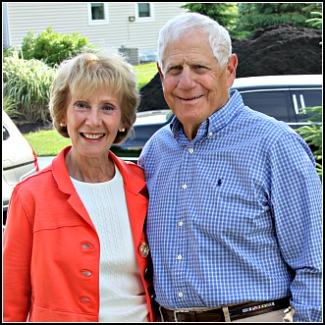 First Impressions First ImpressionsIt was a dark and stormy night and the first football game of the season was under the lights. As I came off the field, caked with mud, one of the cheerleaders, pompoms pumping, cavorted past me. "Watch it," I said, "You could get hurt out here."
My roommate, who was right next to me, said, "Very smooth."
"You could get hurt out here," were the first words I ever spoke to Bette Weber and almost the last. She was a freshman and I was a junior. We had but a nodding acquaintance, no classes together, and our paths rarely crossed, but I was in love.
When the basketball season began I started to go to all the home games, hoping Bette would notice me in the stands. She didn't, but I learned she had the best legs of all the cheerleaders.
The school year passed. She went her way and I went mine. A year later I graduated and two years after that she graduated. End of story -- almost
Story resumes on Seventh Avenue and 44th Street in New York City. I meet Art, a friend from school. We talk. I learn he's a buyer at Montgomery Ward. We agree to meet for lunch. We separate. I walk away, he walks away. He stops, turns. "Hey, ya know who works with me?" he says.
"No, who?"
"Bette Weber," he says."She's an assistant buyer at Wards."
I'm dumbfounded. This is fate as far as I'm concerned. "What's your number over there?"
Forty years later Bette and I were having lunch with my college roommate and his wife. He says to Bette, "Remember your first conversation with Bob, when he told you to get off the field?"
She looks at me in wonder and says, "Oh, was that you?"
Bob & Bette Mendes, Classic Circle
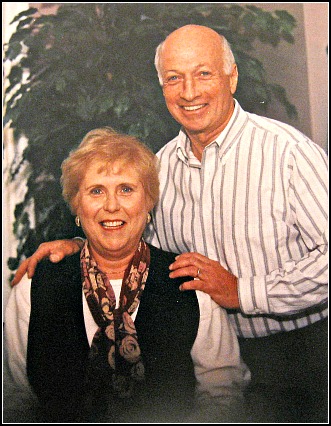 Love At First Sight In the course of my mother's fundraising for Jewish groups and Brandeis University, she met a woman with a daughter named Sunny. Sunny was about my age and we both had grown up just outside of Boston. Our mothers kind of fixed us up and, during my winter break from college in December 1954, I invited Sunny to a movie in downtown Boston. After the break, we both returned to college. She was a sophomore at Barnard College at Columbia University in New York City and I was a senior at UMass/Amherst.
In February 1955, I called Sunny and made a second date. My friend Harold accompanied me to New York in my small Oldsmobile coupe. Sunny fixed him up with Louella, one of her three roommates, and the four of us spent a pleasant evening out in the city before Harold and I returned to Amherst.
On April 28, Harold called Louella to make a second date and we headed south again. Sunny, however, was unavailable; she had a new boyfriend, and we were also bringing our friend Bob with us. So Louella promised to find dates for Bob and me. She was waiting for us in the dorm lobby when we arrived, and two other girls came walking down the stairs -- another of Louella's roommates and a friend. I immediately picked out the girl I wanted to spend the evening with and grabbed her coat...that was Lee. Bob escorted Ellie. We had a delightful evening, dining in the Hawaiian Room of the Hotel Lexington. I recall that the bill came to $44 and we had to pool our cash for the $7 tip!
I fell in love with Lee that night. However, it took her a little longer. But It was meant to be -- both of our folks had summer places at the Cape, just a half mile apart!
We've been happily married since June 19, 1957 and have three terrific kids and six wonderful grandchildren.
Lee & Vic Blumenthal, Leisure Green Drive
Love At Second Sight
Dale and I met at Falmouth Heights Beach on July 19,1969. I was there with my girlfriend Ann Marie for the weekend and it was a miserably drizzly day. We had driven down from Somerville, MA, and were meeting other friends the next day, but this particular day was showing itself to be hard to fill since we had beach and sun on the agenda.
I remember sitting on a bench overlooking the ocean. Two young men approached us, too clean cut for 1969, geeky but cute. We passed a little time sitting and making small talk in the misty fog. I wasn't impressed, but Ann Marie was making plans with Jay to drive to Provincetown that night, so Dale and I reluctantly got caught up in their plans. Turns out the boys were stationed at Ft. Devens, which explained their haircuts. Dale had recently come back from Vietnam. I remember little about Jay except he and Ann Marie were all over each other only to never see each other again.
The trip to Provincetown was uneventful. Dale drove Jay's red Volkswagen so I sat up front with him while the two love birds sat in the rear. On the way back to Falmouth Heights, the Beetle ran out of gas. I accused Dale of planning the whole thing but it wasn't even his car. We spent the night on the side of the highway, cramped into the front seat of the Bug getting to know each other. He talked too much and he was from Ohio, a place on the map about which I had no curiosity.
Early dawn we were rescued by an old man who was going fishing. He had a can of gas, just enough gas to get us to a gas station. I can still see his look of disdain for today's youth, but he was a good Samaritan doing his thing so he stopped.
The boys took us to the guesthouse where we were staying and the matronly innkeeper, who looked like Mrs. Butterworth, scolded us for staying out all night. We cleaned up and met our other friends for breakfast. When we returned, Dale and Jay were waiting for us in the Volkswagen, parked on the lawn where it shouldn't have been. More scolding from Mrs. Butterworth.
"I want to see you again," Dale said to me. He handed me a little black book and asked for my telephone number. I took his pen and wrote, Lydia Jones, (not my real name) 123 Main St., Anywhere, MA. Then something made me put my real phone number down. Off they went. Off we went. I had some good stories to share with friends when I got home.
Three weeks later he called. I wasn't home. My mother gave me the message. I was curiously interested and waited impatiently for him to call again. He did. We made a date to see "Midnight Cowboy" at the Music Hall Theater. He showed up in his own car, a '64 Corvette, which greatly increased his appeal. The movie was sold out so we bought tickets for the 10 pm show, which left us a few hours to kill so we drove up Route 2 to Ft. Devens and back, wasting a soldier's money on gas, and having a really good time.
It was different the second time. I respected our differences. I loved the Corvette; the way it sounded, the way I fit into the passenger seat and the recklessness of it all. I remember saying, "Go fast! Faster! Scare me!"
After the movie he told me that I'd be seeing a lot of him because he liked me. I liked that about him right away, that there wasn't any guesswork, that he called when he said he would and he was up front about his intentions. My Dad was waiting up for me. He said to my father, "Willie, you don't have to wait up, I'll always take your daughter home." Again with the straight shooting.
Our second meeting was my first real date. I was 19, raised strict, and turns out that he was worldly beyond Ohio. We were a good match. A year later, a few months before he got out of the Army, we got engaged and fourteen months after that we were married. Valentine's Day will be 46 years, 6 months and 26 days that we've known each other. Sometimes you just have to press RESTART and begin again.
Lydia & Dale Biersteker, Sea Spray Avenue
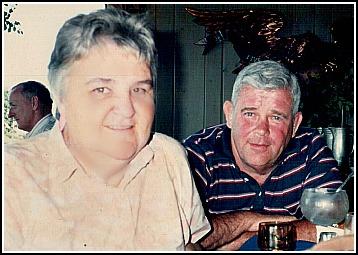 It All Started With A Dare It All Started With A Dare In the sixth grade, at my new school, I was pitching a baseball game. My friend Geoff, who had been a friend since kindergarten at my old school, kept yelling, "We want the other Janet! Put in the other Janet!" as I fumed. When we finally won the game, I went up to Geoff and asked him what his problem was. He just looked at me and kept yelling at me. Madder than I had ever been, I doubled up my fist and hit him, breaking his glasses. Don, a boy who would later become my husband, looked at us and said to Geoff, "Boy, I wouldn't mess with her if I were you." Although I was only 11, my parents made me pay for Geoff's new glasses.
A few year later, in high school, Geoff dared Don and me to go out and we took the dare. We continued to date and eventually married -- for 49+ years. Geoff is still one of my best friends. How many people can claim friends that long?
Jan Cofran, Twin Oaks Drive
The Room Mate Connection
We met because our room mates crossed paths in a grocery store in November 1963, just a few days before President Kennedy was shot.
Cyndi was teaching in East Hartford, CT, after moving from Gloucester, MA two months earlier. Dave was a design engineer at Pratt & Whitney Aircraft. Each of us had three room mates. The key ones were Ann and Al, who had not seen each other since high school in Beverly, MA five years earlier. When they chatted in the dairy aisle, and Ann learned about four single (and gainfully employed) young men, she invited Al to bring his room mates to dinner. Al naturally accepted; a free dinner with pretty women was a huge prize.
The men brought a bottle of Chivas Regal as a house gift; wine was not yet popular in the early '60s. During cocktails, Dave sized up the four young teachers and maneuvered to sit next to Cyndi at dinner. Before the evening was over, he invited her on a lobster dinner date, and 51 years of a happy marriage began 15 months later. Ann has been married for 50 years to another former Pratt & Whitney engineer and remains one of our closest friends.
Dave & Cyndi Fitton, Grey Hawk Drive
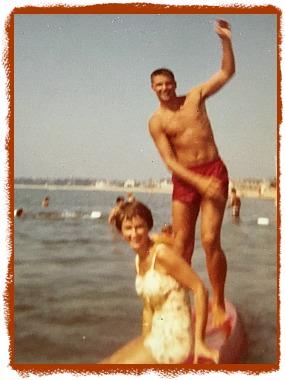 Beach Blanket Bingo Beach Blanket Bingo
It was a hazy, hot and humid summer day in July 1959. A perfect beach day. I was in the fourth year of a five-year stint at the best summer job on Cape Cod -- Craigville Beach lifeguard. Looking forward to a refreshing swim on my next break, I chatted with the head lifeguard, my lifelong friend Bob Cross. He focused my attention on a very attractive young lady alone on a nearby beach blanket and dared me to go over and make her acquaintance. I decided to accept his challenge, never anticipating the great impact this sunny afternoon's decision would have on the rest of my life.
On my next break, I took a deep breath and approached the young lady on the beach blanket and nervously introduced myself. Her name was Judy. She was from New Bedford and vacationing on the Cape for a week with some friends. I asked her if she would like to go for a swim and try out a rescue surfboard. To my astonishment, and that of my buddies, she said "yes."
Romance bloomed. We started dating, fell in love, and married in 1962. Over the next 30 years, we raised a family and were assigned by the US Navy to many duty stations, both stateside and overseas, including Japan and Norway. Now happily married for 53 years, we find ourselves having come full circle back to Cape Cod, the source of our roots and the place where we met and fell in love so many years ago.
Bob & Judy LeBel, Sea Spray Avenue
A Rocky Start
Keith and I met at an Earth Science Technological Association meeting. How's that for romantic settings? My father was in charge of finding a speaker for a meeting of the group, which I always referred to as the "Rock Club." Lucky for him I had just started my career with the the USDA's Soil Conservation Service. I was an eager new employee and my agency wanted to share a water quality report with the world and was looking for venues to present it. As you can guess the Rock Club was going to learn about water quality that month.
During what can only be described as a "flowing" presentation, a very cute guy got up during the talk and headed out of the room. This was my first look at my future husband. After the presentation we talked for a few minutes and then I went home with my folks. A week or so later my father came home from work and said that Keith Rogers had asked him for my phone number. My mother and I both said we were wondering when he would call, which surprised my dad. The minute I met Keith, I felt like we had known each other forever. I know it sounds strange but it's true.
Keith should have asked me for my number the night we met, it would have saved him some embarrassment. Keith and my dad not only worked together, my father was his supervisor and also his landlord. Guess my dad had to provide Keith with the whole package -- a job, an apartment and a wife. Talk about one stop shopping. The Rock Club is gone, the Soil Conservation Service became the Natural Resources Conservation Service, some things change -- but our romance continues.
Liz & Keith Rogers, Chadwick Court
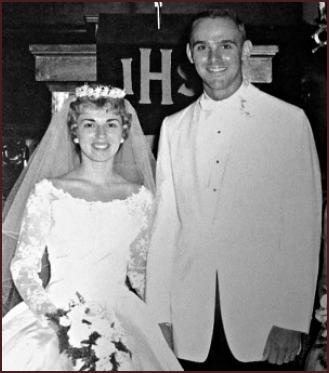 By The Light Of A Bonfire By The Light Of A Bonfire
I first noticed Billie Buchko at a get-acquainted bonfire during Freshmen Week at college. She was blonde, petite and sparkly (still is); it was definitely 'like' at first sight.
Ours was a small, conservative college and various roadblocks were erected to keep us from becoming too involved with members of the opposite sex. Billie was a popular girl and, significantly, she held the key position of evening receptionist and switchboard operator (remember those?) in our men's dorm. More often than not, there was a young man at her window, chatting her up or pouring out his troubles.
We became very good friends over the next three years, but we were kids, dating other people and spending more time enjoying being young instead of thinking about settling down. However, during the summer prior to our senior year, with my final year of college coming up -- and 'real life' looming beyond that, I decided it was time to get serious about finding a mate.
So, impetuous romantic that I am, I sat down and created a kind of grocery list of the attributes I wanted in a wife. Surprise! My good friend Billie met all my criteria; she was obviously my ideal wife-to-be. (Maybe I composed that list with her in mind?)
I determined to win her. When we returned to campus in September, my plan was to monopolize all her free time, leaving her no time to date other guys. It worked; our friendship blossomed into love.
On Election Day, November 1960, I invited her to walk down town and have dinner with me at our favorite Chinese restaurant and there proposed to her (kneeling wasn't really an option in a booth). After a little negotiation, she said "yes." On our way back to the college, we stopped to vote for Richard M. Nixon. Score for that evening: one good choice, one not so good. I met her parents over the winter recess, which could have gone better, but that's another story, and we married in August 1961. We'll celebrate our 55 happy years of togetherness in 2016.
David & Billie Kapp, Bonwood Drive
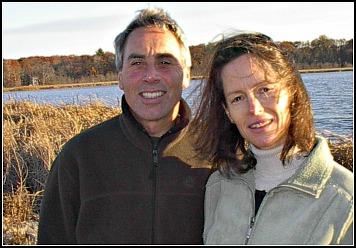 A Near Miss A Near MissI first met Tracy Tebbutt in the summertime at a Boston area swimming pool. I came out of the pool and sat down in my chair and she was seated next to me on a towel, reading. She asked me how the water was. Talk about an opening line. So we chatted for a while until one of us had to go. I thought about asking to get together but couldn't get up the courage to do so. Missed opportunity, or so I thought.
The following Saturday I went back to the pool and she was there again. We talked a lot more and before we knew it the pool was closing. We agreed to meet again the next day -- but It rained on Sunday and we had failed to exchange contact information for getting in touch with one other. The pool was closing for the season on the following Saturday and I had planned a trip to Maine with friends.
I told my co-worker Elena about my situation and asked her if I wrote a letter to Tracy would she go to the pool, hopefully find Tracy and give it to her. Elena agreed. She drove to the pool on the next weekend and found Tracy where I said we had been sitting. After making sure that she was Tracy, Elena told her, "Here's a letter Andy wanted you to have," and then turned around and left.
In my letter, I included my phone number and asked Tracy to call me since that would be the only way we would be able to connect again. I spent a week in Maine anxiously wondering if there would be a message on my answering machine awaiting me when I got home. There was.
Andy Jablon & Tracy Tebbutt, Rolling Green Lane
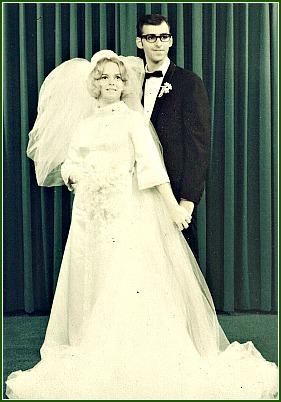 The Voice The VoiceA nasty cold kept me home from work for most of the week, but I had a new dress and shoes, and false eyelashes -- in fashion at the time. My nose was red and runny. My body was drained. I talked like a frog. How could I go to my cousin's wedding? My parents went to the church without me; I would try to pull myself together for the reception. My cousin said she was seating me at a table of bachelors. I could do it!
Arriving at the reception hall, I made my way to the table. Introductions all around; they were indeed bachelors, but every one of them was already engaged to be married! It was time for the wedding party to be introduced and we all stood in anticipation. Bridesmaids and ushers came first. A chunky bridesmaid entered the room on the arm of a handsome usher. I became all warm and fuzzy. A voice from an unknown source whispered in my ear...
"That is the boy you are going to marry."
My eyes followed this young man to the dais where the wedding party would sit, and I remember thinking that he would be required to stay with the wedding party. I would never get to meet him.
In the next few minutes, as the boys at my table joked and laughed, a young man appeared next to our table, dressed in a tuxedo complete with tails. My gaze went to the identification bracelet on his wrist, hair swept off his brow like Fabian, fantastic olive complexion. Then, with a gorgeous smile, he said "Hi."
He asked me to dance and we danced the whole afternoon. During our last dance, he managed a slick maneuver and asked me out for our first date that night. Two weeks later, in the shadow of the Verrazano Bridge, he asked me to marry him. In less than year we fulfilled the prophesy of The Voice by getting married. Through sickness and health, good times and bad, we are here 48 years later.
Nancy & Lou DiFinzio, Grey Hawk Drive
|
 | |
Winter Birds
by Bob Fulton
Sitting by my window in the early morning light
watching the birds,
a simple joy.
My way of making winter more comfortable for those
without a fire to warm them.
Sometimes, I feel like inviting them in to shelter.
They're tiny, fragile,
with just feathers to protect them from the elements.
Usually, in the worst of cold and snow,
they share the seeds and suet I provide,
all getting along in their time of need.
At other times they bicker and bully,
claiming ownership of the feeder.
What or who do they think provides this
endless supply of food when nature is less generous?
Do they see me, shoveling a path in the storm,
filling the feeder and
sprinkling seed for the ground feeders?
No matter.
The pleasure they provide more than makes up
for the effort involved.
In my heart of hearts,
I like to pretend that I am to them
some benevolent god,
providing for their needs in a time of want.
|
|
COOKING
Pressure Cooker Heaven
by Ray Schumack
|
 One morning recently, still half asleep, I turned on the television and started to watch an infomercial. One of those fast-talking TV chefs was demonstrating how his marvelous power pressure cooker could make complete scrumptious meals -- in just a few minutes!
This struck me as interesting, (remember, I was still half asleep). I usually don't start thinking about what I want for dinner until about 4:00 pm, and that doesn't allow enough time to make beef bourguignon in my a slow cooker. It also reminded me of the Stone Age pressure cooker my family had during my teenage years.
My mother was a stay-at-home mom. She was always there to make lunch for me when I came home from grammar school. When I started high school, however, America was struggling through the first year of World War II. That's when Mom decided to become Rosie the Riveter. But there were no bomber factories needing riveters in Long Island City, so Mom became a drill press operator making machine gun parts. That's when I learned to use a pressure cooker to make dinner for the family.
In the morning, before going to work at the machine gun factory, Mom would assemble the dinner ingredients in our ancient pressure cooker. She most often included a pot roast, carrots and potatoes covered in water. In those days, even with meat rationing, you could buy a nice tender pot roast, not like the shoe leather you get at the supermarket today. Mom instructed me to turn on the gas burner under the pressure cooker as soon as I got home from school. Within a few minutes the pressure cooker valve would sputter and dance, a sign that the gas flame had to be turned down. After the food cooked for about 20 minutes, I turned the flame off and let the pot sit on the stove until Mom, Dad and my sister came home from work.
Until I watched my early-morning infomercial, I assumed that no one used a pressure cooker anymore. But now I was intrigued, and when this happens I usually start researching with Google. As it turns out, all types of pressure cookers are still available, ranging in price from $14.95 to as much as $200, most of them more sophisticated and safer than the old dinosaur pressure cookers. Hundreds of recipes are available online. There is even a blog by a woman, Miss Vickie, who has dedicated her life to informing her followers how to use a pressure cooker to make any kind of meal or baked goods, including down home cornbread!
I now have a pressure cooker. It cost less than $70 and is constructed of heavy, solid stainless steel, much like a high-end chef pan costing three times as much. It arrived via Amazon Prime in two days and can be returned without question if I don't like it. But it works great. I can now make a half-gallon of carrot soup from a pound of carrots in five minutes! You can check out Miss Vickie's blog at http://missvickie.blogspot.com/.
P.S. The trick to making a tasty, tender beef stew in your new pressure cooker, given today's tough supermarket meats, is to keep cooking the meat until it falls apart when pierced with a fork. All my pressure cooker recipes recommend cooking the beef for 20 minutes, then adding vegetables and cooking for another 10 minutes. But my stew required browning a big piece of chuck, then cutting it into bite-size pieces, cooking them for 30 minutes and then adding vegetables and cooking for another 15 minutes -- or 1/3 longer than recommended by the recipes.
|
|
NON COMPOS MENDES
Bob Mendes
|
- Sarah Palin's back! She lost the presidency for John McCain in 2008; let's see what she can do for Trump.
- How come most vacuum cleaners don't have a retractable cord?
Because men design vacuum cleaners and women use them.
- I don't think I'll ever abandon the printed page. Sounds strange coming from a person who writes a column for an on-line publication, but It's too satisfying to hold a book printed on paper in my hands, turn the pages and just read -- with no electronic enhancements. Is this a generational thing?
- Fortune cookies get a bad rap (pun unintended), but every once in a while you get a gem. Here's a fortune cookie message that surfaced at the end of my last Chinese meal: "The most important things in life are not things."
Think about it.
- A word to the wise. Lately, I've been getting messages in my spam folder, ostensibly from "Southport punch list." I opened one and it seemed to be some sort of scam. I don't know what they're about, but if you get one, I would advise against opening it.
- With all the talk about the Powerball Lottery winners and how lucky they are, I think it's time to reveal that I, Bob Mendes, am a California Lottery Winner. I bought a $1 ticket on the very first day that California started its lottery. It yielded $2 in winnings. With that $2 I bought two more $1 tickets and one of them was a $5 winner. I never bought another ticket, therefore, I am $3 ahead, a lottery winner!
- I have no idea what a jury trial costs, but it has to be up into seven figures, maybe eight. What, then, is the point of trying Aaron Hernandez for the murder of two men? He's already serving a life sentence without the possibility of parole for his first murder. It reminds me of the story where a man is run over by a car. The driver stops, opens the door, leans out and shouts at the man, "Watch out." "What're you gonna do now?" yells the man at the driver, "Back up?"
- I've been going to too many funerals lately. Sure, it's a fact of life, people die, but listening to some of the eulogies it struck me that it's too bad the deceased isn't alive to hear these wonderful words of praise. So here's what we should do -- start a series of "FUNerals," where we can tell people, while they're still alive, how much they're appreciated. Any takers?
- Has anyone in the media ever surveyed those couples where the guy proposed publicly, like on a stadium scoreboard or with skywriting, to see how many of those marriages last? I bet not many.
- Is it really unsafe to shower during a thunderstorm? How does the lightning know you're in the shower?
- FINAL THOUGHT I must be missing something. We on Cape Cod are in the middle of a drug and opiate crisis and I read a front page story in the Cape Cod Times about new marijuana stores opening up. Okay, you say, it's 'medical marijuana.' Well, opiates are all medically prescribed as well. If ever there was a disconnect in thinking, this is it!
|
Day Boat Love
by Lydia Biersteker
|
My heart sails on the sea of you,
forever calm, reliably so
I row and row
sometimes feeling turmoil
but undeniably always
within my skiff.
I am my own storm.
I rock and knock about
but the sea of you
takes me home each night
then sets me back
on the briny in the morn
with a kiss and assurance that
I'm always safe.
|
|
HISTORY
A Preventable Tragedy:
The Shirtwaist Triangle Factory Fire
by Tom Kelleher
|
Over the last 45 years, the federal Occupational Health and Safety Administration (OSHA), in cooperation with state agencies, has tried to ensure fundamental health and safety standards for American workers. The road to accomplish this has been long and arduous, and one that continues. The workplace has often been a dangerous and unhealthy place, and this was especially true in the 19th and early 20th centuries. It has taken the tireless efforts of labor reformers, progressive politicians, officials at all levels - and many avoidable tragedies -- to bring about change.
The impetus behind the move toward greater safety for workers began with one of the worst industrial accidents in American history -- the Triangle Shirtwaist Factory fire, which occurred in New York City in 1911. This tragedy was preventable, but lack of concern for worker safety by the owners Max Blanck and Isaac Harris, led instead to the death of 146 workers.
|
| |
Factory owners Max Blanck and Isaac Harris (front, right of center) with workers and others on the occasion of occupying the 8th floor of their factory.
|
Blanck and Harris had a history of fires in their other businesses. Due to collusion and corruption between the garment industry and New York City officials, it was common practice for factory owners to torch their buildings and collect the insurance they carried on their factories. Blanck and Harris had collected on a fire in a previously owned building and on another smaller fire in the Triangle Shirtwaist Factory itself in 1909. In that same year, the Garment Workers Union had organized a strike calling for reforms in the workplace, but Blanck and Harris refused to give in to demands for shorter hours, better pay and safer working conditions.
The Triangle Shirtwaist Factory specialized in making the fashionable "shirtwaist" -- a blouse with a narrow waist, high collar and puffy sleeves.
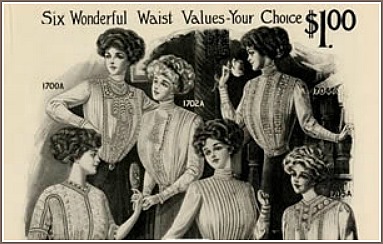 Blanck and Harris became rich in this market by exploiting their workers. The factory was a sweatshop, occupying the top three floors of a ten-story building in Lower Manhattan. Most of the workers were teenage immigrant women who spoke no English. They worked in cramped quarters among long lines of sewing machines, large tables and cloth bins. They worked 12 hours a day, every day for $15 a week. There were four elevators in the building but only one was functional. There were two stairwells, one of which was locked from the outside to prevent workers from stealing cloth, and the other stairwell exit door opened from the inside. The building had one fire escape, but it buckled and collapsed when workers tried to use it to escape the fire. The owners were not required to follow safety rules and they refused to install a sprinkling system. The fire broke out in a rag bin on Saturday afternoon, March 25. A manager tried to extinguish it with a fire hose but the hose had rotted and the water valve had rusted shut. Panic spread rapidly as the fire expanded, consuming the large amount of flammable materials on hand. The single elevator (with a capacity of just 12 people) broke down after only four evacuation attempts. As the flames spread, many women jumped to their deaths down the elevator shaft. Workers on the top floor -- and the owners -- were able to escape to the roof and jump to adjacent rooftops. Those on the 8th and 9th floors were trapped. Many women stampeded down the stairwell only to find the door locked. They were burned alive. 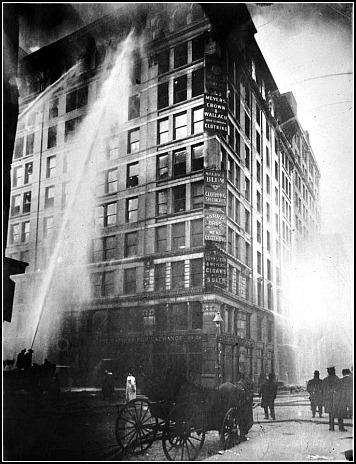 As the fire department rushed to the scene and spectators gathered on the streets, all witnessed the unfolding horror. Women jumping to their deaths often landed on the fire hoses, impeding rescue efforts. Fire safety nets tore like paper as multiple jumpers hit the nets simultaneously. Spectators watched helplessly as many women, resigned to their fate, embraced one another and jumped together, sometimes with hair and dresses ablaze. The tragedy was over in about 18 minutes. A total of 146 workers died, making the Triangle Shirtwaist Factory Fire the worst workplace disaster in New York City history until the terrorist attacks on the World Trade Center on 9/11!
As families tried desperately to identify the remains of loved ones, anger spread throughout the immigrant community in lower Manhattan, especially after a grand jury failed to indict the owners on manslaughter charges, despite the evidence of their gross negligence. Rising anger also led to a worker union march down Fifth Avenue, which was supported by an estimated 80,000 people. Shockwaves resulting from the fire spread throughout the country, and the Labor Movement and other reform groups began to organize and fight for new regulations to improve the lives and safety of both women's and immigrants's rights in the workplace. Frances Perkins, who witnessed the fire firsthand, sought to turn the tragedy into an opportunity for progress. She, Senator Robert Wagner and Governor Al Smith, working with local and state officials, helped to end the practice of ignoring workplace conditions and laid the groundwork for reform in New York City, which later served as an example for the nation. In the decades immediately following the Triangle Factory fire, reform efforts continued at the federal level, led at that point by Secretary of Labor Frances Perkins and resulting in the passage of the National Labor Relations Act in 1935. This act granted new rights to workers and included restrictions on child labor (an important reform given that many victims of the Triangle Factory fire were as young as 13). The culmination of these early efforts at workplace reform came with the creation of OSHA - the federal agency overseeing health and safety standards for American workers. Unfortunately, no such agency protected the workers of the Triangle Shirtwaist Factory, but their tragedy has led to a continuing effort to provide safe and healthy workplace conditions for their descendants.
|
|
Out & About At Southport
|
|
| |
Southport Quilters displaying the quilt they've created for the annual Pastabilities Raffle in May
|
New Year's Eve Couples
|
| |
Bob Lebel (taking the photo), Frank Philips (left) and Don Sostek played hockey on Martha Pond
just before the recent storm covered the ice with snow.
|
Quilting Projects
Photos: Bonnie Towle
|
| |
Penny Hersey's Christmas Tree Skirt
|
|
|
| |
Nancy Brown's Granddaughter Quilt
|
|
|
| |
Second Annual New Year's Day Tennis, Photo: Tom Fredian
|
Dine-Around at Wimpy's
Photos: Larry Cron
|
|
Contributors to the
February 2016 Edition of
Southport Village Voices
|

Lydia Biersteker
grew up in Somerville, MA. She met her husband Dale on the beach at Falmouth Heights in 1969, while he was stationed at Fort Devens. After Dale retired in 2005 from his executive position with the USPS, they moved to Vero Beach, FL but decided that they preferred New England. They moved to Southport in 2011. Dale plays golf, and Lydia likes gardening, walking, writing poetry and short prose, exploring genealogy, and lunching with friends. Together, they enjoy dining, exploring wineries and brew pubs, walking the trails of Cape Cod, traveling and playing with their grandkids, who live on the North Shore.

Bob Fulton
grew up in Fairfield CT where he met Lynn in high school and later married her in 1967. After a tour of duty with the US Army in Vietnam, he completed his MA degree at the University of Connecticut and then embarked on a 30-year career teaching history and social studies to middle school students in Storrs. Once retired, he and Lynn taught at UConn until 2008 and then participated in a four-year federal grant program to improve the teaching of United States history. A sense of curiosity about the world and a shared love of history led them to travel extensively in the US, Canada and Europe, bicycling, backpacking and traveling by train. They settled in Pocasset 15 years ago, moved to Southport in 2015 and are trying with great success to live happily ever after. You'll often find Bob on the golf course, in the pool or hot tub or walking around the village, ready to talk with everyone he meets.
 David Kapp David Kappwith his wife Billie, moved from Connecticut to Southport in 2009. David retired from a career as a university library administrator, after working in the libraries at Brandeis, Harvard and the University of Connecticut. He was a building consultant for the planning of a number of major university libraries and was, for many years, the editor of Connecticut Libraries. Billie enjoyed a career as an educator and social sciences consultant. The Kapps are frequent visitors to Hawaii where their daughter, son, grandson and many other family members live.
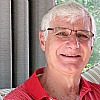 Tom Kelleher Tom Kelleher
grew up in Lowell, MA and stayed in that area after marrying Kathryn, his "college sweetheart" and wife of 43 years. After raising a family of five children and somehow paying for five private college educations, Tom and Kathryn retired to Southport in August 2014. Tom pursued a career in public and private education that spanned 42 years. He was a teacher and administrator at Dracut High School and later principal at Nashua Catholic Regional Junior High in Nashua, NH. Upon retirement and prior to moving to Southport, Tom took on a "fun" job as a part-time museum teacher and history tour guide at Lowell National Historical Park. In addition to history, Tom's other passion is singing and playing guitar in various "open mic" and song circle venues in the Falmouth/Sandwich area. Tom also performs for patients at the Tradewinds Adult Day Care Center in Sandwich.
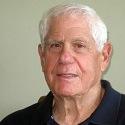 Bob Mendes Bob Mendes
began his career as an advertising copywriter at Doyle Dane Bernbach in NYC before becoming senior vice president of marketing for a west coast department store chain. He left that position to start Pacific Sports, a sports and general marketing agency. There he developed "The Reading Team," a children's literacy program sponsored by the NFL and the American Library Association, using NFL players as literacy role models. Bob is the author of "A Twentieth Century Odyssey, the Bob Mathias Story." After retiring, he served as executive director of the Glendora, CA Chamber of Commerce. When grandson Adam was born, Bob and Bette moved to Cape Cod. He's had a number of part-time jobs, has written two more books, and volunteers. Bette serves on the Board of Governors and volunteers at the Falmouth Jewish Congregation. Their son Steve, a pediatrician, lives in Marion with his wife Sarah and their children; a second son, Jeff, practices law in Indianapolis.
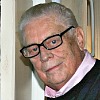 Ray Schumack Ray Schumack
has held positions as a magazine editor, publicity director and an account executive for a Madison Avenue advertising and public relations agency. He served for 15 years as chief communications officer for a Fortune 500 company, responsible for all corporate communications and product promotion literature. His business articles have appeared in the Wall Street Journal, the New York Times, Fortune magazine and elsewhere. He established his own public relations firm and continues to serve several clients in retirement. His recent memoir, News Releases from the Korean War, recounts his experiences as a war correspondent.
Special Thanks To
the residents who shared their 'how we met' stories,
the photographers who sent pictures for this issue,
and to my proofreader Billie Kapp
|
|
|
|
|
|
|
|